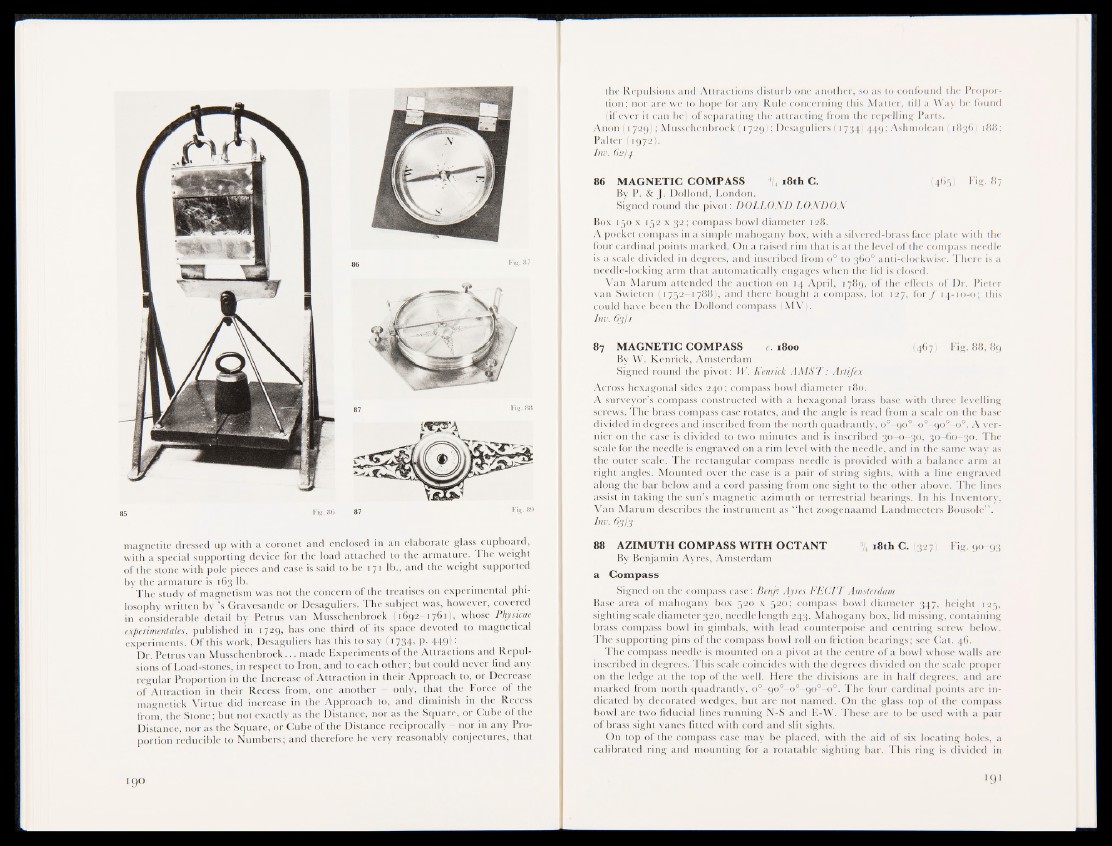
85 Fig. 8S- 87 F'g- 89
magnetite dressed up with a coronet and enclosed in an elaborate glass cupboard,
with a special supporting device for the load attached to the armature. The weight
of the stone with pole pieces and case is said to be 17* lb., and the weight supported
by the armature is 163 lb.
The study of magnetism was not the concern of the treatises on experimental philosophy
written b y ’s Gravesande or Desaguliers. The subject was, however, covered
in considerable detail by Petrus van Musschenbroek (1692-176 ifg whose Physicae
experimentales, published in 1729, has one third of its space devoted to magnetical
experiments. Of this work, Desaguliers has this to say (1734r? P- 449) •
Dr. Petrus van Musschenbroek... made Experiments of the Attractions and Repulsions
of Load-stones, in respect to Iron, and to each other; but could never find any
regular Proportion in the Increase of Attraction in their Approach to, or Decrease
of Attraction in their Recess from, one another.jr only, that the Force of the
magnetick Virtue did increase in the Approach to, and diminish in the Recess
from, the Stone; but not exactly as the Distance, nor as the Square, or Cube of the
Distance, nor as the Square, or Cube of the Distance reciprocally*- nor in any Proportion
reducible to Numbers; and therefore he very reasonably conjectures, that
the Repulsions and Attractions disturb one another, so as to confound the Proportion;
nor are we to hope for any Rule concerning this Matter, till a Way be found
(if ever it can be) of separating the attracting from the repelling Parts.
Anon (1729); Musschenbroek (1729); Desaguliers (1734) 449; Asbmolean (1836) 188;
Palter (1972).
Inv. 62/4
86 MAGNETIC COMPASS * U i 8t h C . (465) Fig. 87
By P. & J. Dollond, London.
Signed round the pivot: DOLLOND LONDON
Box 150 x 152 x 32; compass bowl diameter 128.
A pocket compass in a simple mahogany box, with a silvered-brass face plate with the
four cardinal points marked. On a raised rim that is at the level of the compass needle
is a scale divided in degrees, and inscribed from o° to 360° anti-clockwise. There is a
needle-locking arm that automatically engages when the lid is closed.
Van Marum attended the auction on 14 April, 1789, of the effects of Dr. Pieter
van SwietenHh752— 1788), and there bought a compass, lot 127, for f 14-10-0; this
could have been the Dollond compass (MV).
Inv. 63J1
87 MAGNETIC COMPASS c. 1800 (467) Fig. 88,89
By W. Kenrick, Amsterdam
Signed round the pivot: W. Kenrick AMST: Artifex
Across hexagonal sides 240; compass bowl diameter 180.
A surveyor’s compass constructed with a hexagonal brass base with three levelling
screws. The brass compass case rotates, and the angle is read from a scale on the base
divided in degrees and inscribed from the north quadrantly, o°—90°—o°—90°—0°. A vernier
on the case is divided to two minutes and is inscribed 30—0—30, 30—60—30. The
scale for the needle is engraved on a rim level with the needle, and in the same way as
the outer scale. The rectangular compass needle is provided with a balance arm at
right angles. Mounted over the case is a pair of string sights, with a line engraved
along the bar below and a cord passing from one sight to the other above. The lines
assist in taking the sun’s magnetic azimuth or terrestrial bearings. In his Inventory,
Van M; irum describes the instrument as “ het zoogenaamd Landmeeters Bousole” .
Inv. 6313
88 AZIMUTH COMPASS WITH OCTANT % 18th C. (327) Fig. 90-93
By Benjamin Ayres, Amsterdam
a Compass
Signed on the compass case: Benjn. Ayres FECIT Amsterdam
Base area of mahogany box 520 x 520; compass bowl diameter 347, height 12^,
sighting scale diameter 320, needle length 243. Mahogany box, lid missing, containing
brass compass bowl in gimbals, with lead counterpoise and centring screw below.
The supporting pins of the compass bowl roll on friction bearings; see Cat. 46.
The compass needle is mounted on a pivot at the centre of a bowl whose walls are
inscribed in degrees. This scale coincides with the degrees divided on the scale proper
on the ledge at the top of the we 11. Hf ;re the divisions are in half degrees, and are
marked from north quadrantly, o°—900—o°—900—o°. The four cardinal points are indicated
by decorated wedges, but are not named. On the glass top of the compass
bowl are two fiducial lines running N-S and E-W. These are to be used with a pair
of brass sight vanes fitted with cord and slit sights.
On top of the compass case may be placed, with the aid of six locating holes, a
calibrated ring and mounting for a rotatable sighting bar. This ring is divided in
I9 I